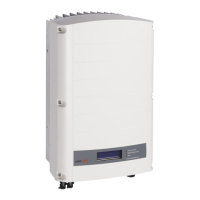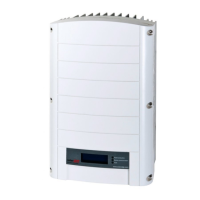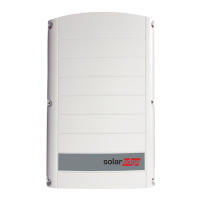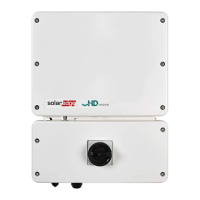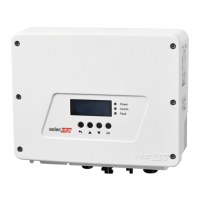What to do if SolarEdge Inverter displays 'Ground Disconnected Disconnect from EV'?
- MMisty MooreSep 12, 2025
If the SolarEdge Inverter shows 'Ground Disconnected Disconnect from EV', disconnect the EV Charger cable from the vehicle.

What to do if SolarEdge Inverter displays 'Ground Disconnected Disconnect from EV'?
If the SolarEdge Inverter shows 'Ground Disconnected Disconnect from EV', disconnect the EV Charger cable from the vehicle.
What to do if SolarEdge SE3680H shows 'Internal Error Disconnect from EV'?
If your SolarEdge Inverter displays the message 'Internal Error Disconnect from EV', disconnect the EV Charger cable from the vehicle. Then, turn the inverter AC circuit breaker OFF and then ON again. Finally, reconnect the EV Charger Cable to the vehicle.
Why does my SolarEdge Inverter display 'Vent not supported Disconnect from EV'?
If your SolarEdge Inverter displays 'Vent not supported Disconnect from EV', the vehicle cannot be charged, because the SolarEdge EV charger does not charge vehicles that require ventilation while charging.
What to do if SolarEdge SE3680H shows 'Charging retries ended Disconnect from EV'?
If your SolarEdge Inverter displays 'Charging retries ended Disconnect from EV', disconnect the EV Charger cable from the vehicle and contact SolarEdge Support.
What causes 'Pairing failed' on SolarEdge Inverter and how to fix it?
If your SolarEdge Inverter displays 'Pairing failed', it means power optimizers are shaded. If you connected the inverter to the monitoring platform, retry pairing remotely (during sunlight). Make sure to leave the inverter ON/OFF/P switch ON and that S_OK appears in the status screen.
What does 'Ground Fault (RCD) Press Charge Now' mean on SolarEdge SE3680H Inverter?
If your SolarEdge Inverter displays 'Ground Fault (RCD) Press Charge Now', it means the EV Charger detected a ground fault. Press the Charge Now pushbutton on the Connection Unit.
What does 'Internal Error Disconnect from EV' mean on SolarEdge Inverter?
If your SolarEdge Inverter displays 'Internal Error Disconnect from EV', it means there is an internal error. Disconnect the EV Charger cable from the vehicle. Turn the inverter AC circuit breaker OFF and ON. Reconnect the EV Charger Cable to the vehicle.
What to do if SolarEdge SE3680H Inverter displays 'Over Voltage Press Charge Now'?
If your SolarEdge Inverter displays 'Over Voltage Press Charge Now' it is because the EV Charger AC voltage is too high. Press the Charge Now pushbutton on the Connection Unit or tap Charge Now on the EV Charger tab of the Monitoring App.
What does 'Over Current Press Charge Now' mean on SolarEdge SE3680H?
If your SolarEdge Inverter displays 'Over Current Press Charge Now' it is caused by EV Charger AC over current. Press the Charge Now pushbutton on the Connection Unit or tap Charge Now on the EV Charger tab of the Monitoring App.
How to fix 'String voltage is 0V' on SolarEdge SE3680H?
If your SolarEdge Inverter displays 'String voltage is 0V', it means a power optimizer output is disconnected. Connect all power optimizer outputs.
| AC Output Power | 3680 W |
|---|---|
| Protection Rating | IP65 |
| Rated AC Power | 3680 W |
| AC Frequency | 50/60 Hz |
| Max. Input DC Voltage | 480 Vdc |
| Number of MPP Trackers | 1 |
| Warranty | 12 years |
| Cooling | Convection |
| Operating Temperature Range | -25°C to 60°C |
| AC Voltage | 220/230 V |
Explains the meaning of various safety symbols used within the document.
Describes DC-DC converters that maximize power harvesting at the module level.
Explains the platform for monitoring technical and financial performance of SolarEdge sites.
Details the inverter's function in converting DC to AC and EV charging capabilities.
Lists the standard tools and equipment recommended for installing the SolarEdge system.
Outlines essential safety notes and warnings applicable when installing power optimizers.
Provides guidelines for installing power optimizers, including string length and cable rules.
Lists the items included in the inverter package for installation.
Explains how to identify the inverter using its serial number and electrical ratings.
Shows the connectors and interfaces on the inverter and connection unit.
Details the EV charger connector, LED indicator, and other ports on the connection unit.
Describes the ON/OFF/P switch and inverter LED indicators for status.
Explains how to set the circuit breaker rating DIP switches on the connection unit.
Details the buzzer indications for different EV charger events like connection and errors.
Provides instructions and clearance requirements for mounting the inverter.
Guides on selecting and configuring Residual Current Devices for system protection.
Instructions for activating the installation using the SetApp mobile application.
Steps for commissioning and configuring inverter settings via the SetApp.
How to configure country, grid, and language settings for inverter compliance.
Procedure for pairing the inverter with power optimizers and system components.
Details on configuring communication settings for monitoring platform connectivity.
Information on power control options like Grid Control and Energy Manager.
Steps to verify the proper activation and commissioning of the SolarEdge system.
How to access and interpret the system status screen for inverter settings and operation.
Details on the main inverter status screen, including power, voltage, and connectivity.
Shows the accumulated status of all inverters connected in a chain and the leader inverter status.
Displays the status of various communication options like LAN, RS485, Wi-Fi, and Cellular.
Shows the total energy produced by the inverter over different periods.
Details the status of production and export meters connected to the inverter.
Displays the EV charging status, mode, and energy added to the EV.
Instructions for connecting the site to the monitoring platform for data reporting.
Explains the features and benefits of the SolarEdge monitoring platform.
Guides on creating logical and physical layouts for system components in the platform.
Information on using the Designer tool for inverter and optimizer selection and report generation.
Details on using the smartphone app to scan components and create a PV site map.
Instructions for accessing the site creation page and mapping physical layouts.
How to use a physical layout template and stickers for mapping PV site components.
Lists the available communication types for transferring monitored information.
Instructions for establishing an Ethernet connection for LAN communication.
Details the available RS485 ports for connecting multiple devices.
How to use Wi-Fi connection for linking the inverter to the monitoring platform.
Information on using a cellular connection for wireless monitoring via a plug-in.
Describes the functionality of the communication gland openings for various connection types.
Step-by-step guide to connect the inverter to the monitoring platform via Ethernet.
Instructions for connecting multiple inverters in a bus configuration using RS485.
Steps to check if the communication connection to the monitoring server is successfully established.
Methods to identify system errors indicated by LEDs, codes, or the monitoring platform.
Troubleshooting steps for common errors related to the EV charger function.
Guides for troubleshooting communication issues with Ethernet and RS485 connections.
Specific steps to troubleshoot RS485 communication problems, like leader not found.
General troubleshooting steps for network and modem connectivity issues.
Procedure for replacing the fuse located in the inverter.
Step-by-step guide for replacing an existing inverter with a new one.
Instructions for replacing the connection unit of the inverter system.
Details on setting DIP switches for Modbus address and RS485 termination.
Configuration of Modbus addresses for the energy meter using DIP switches.
Configuration of RS485 wiring termination using DIP switches on the energy meter.
Technical data for inverter AC/DC output, voltage, current, efficiency, and compliance.
Specifications related to cable diameter, cross-section, dimensions, and weight.
Default voltage and frequency trip limits and clearing times compliant with IEEE1547.
Technical details for the EV charger, its charging modes, and cable specifications.
Provides dimensional drawings and specifications for the inverter unit.
Contact details and required information for technical support with SolarEdge products.


